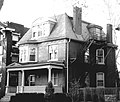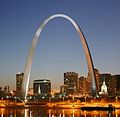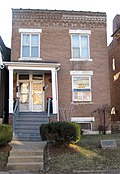List of National Historic Landmarks in Missouri
The
114 counties and one independent city, with a concentration of fifteen landmarks in the state's only independent city, St. Louis
.
The
U.S. Secretary of the Interior. However, the owner of a property may object to the designation of that property as an NHL. In such cases, the site is only "eligible for designation." A property eligible for NHL status is also eligible for listing on the National Register of Historic Places (NRHP).[4][5] Designated National Historic Landmarks are listed on the NRHP, which includes historic properties that the National Park Service has determined to be worthy of preservation. While NHL areas are deemed to carry national historic significance, other NRHP properties may only be significant at local or state levels.[4]
Five historic sites in Missouri are in the
Current National Historic Landmarks
Legend
| |
| [nb 1] | Site type
|
| National Historic Landmark | |
| National Historic Landmark District | |
| National Historic Site | |
| National Monument | |
| National Memorial | |
| National Battlefield |
| [nb 1] | Landmark name | Image | Date designated[nb 2] | Location | County | Description |
|---|---|---|---|---|---|---|
| 1 | Anheuser-Busch Brewery
|
 |
November 13, 1966 (#66000945) |
St. Louis 38°35′51″N 90°12′44″W / 38.5975°N 90.2122°W | St. Louis (independent city) | The buildings in Anheuser-Busch's brewing district date from the late 1800s and are made of brick. Many are decorated with gargoyles and other such figures on the exterior. In addition, the company has also added new buildings and renovated older ones, but the district's status as a historic site has not been compromised.[8] |
| 2 | Arrow Rock |  |
May 23, 1963 (#66000422) |
Arrow Rock 39°04′01″N 92°56′42″W / 39.067°N 92.945°W | Saline | The crossing of the American West. A ferry was later established near Arrow Rock, at what became a starting point for traders on the Santa Fe Trail. The district is now home to Arrow Rock State Park.[9]
|
| 3 | George Caleb Bingham House |  |
December 21, 1965 (#66000423) |
Arrow Rock 39°04′16″N 92°56′35″W / 39.071°N 92.943°W | Saline | George Caleb Bingham, a painter, lived in this house from 1837 to 1845. During his time at this house, Bingham first sketched the Missouri River and local frontier life that later turned into his "genre" works.[10] |
| 4 | Louis Bolduc House |  |
April 15, 1970 (#69000305) |
Ste. Genevieve 37°59′20″N 90°03′14″W / 37.989°N 90.054°W | Ste. Genevieve | This home was the residence of bouzillage (clay and grass) as a wall filling.[11]
|
| 5 | Carrington Osage Village Site
|
 |
July 19, 1964 (#66000425) |
Nevada 37°58′52″N 94°12′35″W / 37.981111°N 94.209722°W | Vernon | This site was occupied by the Big Osage tribe of Native Americans from around 1775–1825, and was the group's last area of residence in the southwestern portion of Missouri, as they were later confined to a Kansas reservation. The site is representative of the culture of the Big Osage, because it appears to have been a major trading area for the tribe.[12] Now the Osage Village State Historic Site. |
| 6 | Christ Church Cathedral |  |
October 12, 1994 (#90000345) |
St. Louis 38°37′49″N 90°11′55″W / 38.6303°N 90.1986°W | St. Louis (independent city) | Construction for the church began in 1859, but the structure was not completed until 1867. The Gothic Revival building was designed by architect Leopold Eidlitz, even though he was not devoted to the Gothic style.[13]
|
| 7 | "Champ" Clark House |  |
December 8, 1976 (#76001114) |
Bowling Green 39°20′29″N 91°11′26″W / 39.3415°N 91.1905°W | Pike | This house served as the residence of Speaker of the U.S. House of Representatives from 1911 to 1919.[14]
|
| 8 | Eads Bridge |  |
January 29, 1964 (#66000946) |
St. Louis 38°38′N 90°10′W / 38.63°N 90.17°W | St. Louis (independent city) | This steel bridge was built in 1874, at a total length of 6,442 feet (1,964 m). It was designed by Captain James B. Eads, who used a system of cantilevers to allow for the bridge's long length. At the time of its construction, the Eads Bridge was used primarily as a means to connect railroads running westward to Missouri and those running eastward to Illinois.[15]
|
| 9 | Joseph Erlanger House |  |
December 8, 1976 (#76002234) |
St. Louis 38°39′N 90°16′W / 38.65°N 90.27°W | St. Louis (independent city) | This house was the home of physiologist and a co-recipient of the 1944 Nobel Prize in Physiology or Medicine. More recently, the house fell into a state of disrepair because its owner was unable to maintain the structure.[16]
|
| 10 | Field House
|
 |
March 29, 2007 (#75002137) |
St. Louis 38°37′12″N 90°11′31″W / 38.620°N 90.192°W | St. Louis (independent city) | This was the home of attorney Scott v. Sandford (1857).[17] Also the birthplace of Field's son, author Eugene Field, the house is currently known as the Eugene Field House and St. Louis Toy Museum.[18]
|
| 11 | Fort Osage | November 5, 1961 (#66000418) |
Sibley 39°11′16″N 94°11′33″W / 39.1878°N 94.1925°W | Jackson | This William Clark in 1808. Built for the protection of the Osage Indians, Fort Osage experienced success in as a trade house until the end of the factory system in 1822.[19]
| |
| 12 | Gateway Arch |  |
May 28, 1987 (#87001423) |
St. Louis 38°37′31″N 90°11′00″W / 38.6253°N 90.1833°W | St. Louis (independent city) | The tallest man-made monument in the U.S., the arch is based on a Finnish American architect Eero Saarinen. In 1967, the 630 feet (190 m) structure was opened to the public as part of the Jefferson National Expansion Memorial, which was renamed as Gateway Arch National Park in 2018.[20][21]
|
| 13 | Graham Cave | January 20, 1961 (#66000420) |
Mineola 38°54′20″N 91°34′32″W / 38.9055°N 91.5756°W | Montgomery | In 1949, remnants of Archaic American civilization were found in this cave. Dating back to 8,000 B.C., these remains indicate a blending of Eastern and Plains cultures at Graham Cave, which is now part of Graham Cave State Park.[22]
| |
| 14 | Scott Joplin Residence
|
 |
December 8, 1976 (#76002235) |
St. Louis 38°38′14″N 90°12′54″W / 38.6371°N 90.2151°W | St. Louis (independent city) | |
| 15 | Liberty Memorial
|
 |
September 20, 2006 (#00001148) |
Kansas City 39°04′49″N 94°35′10″W / 39.080278°N 94.586111°W | Jackson | This building of this memorial started with a group of about 40 citizens, a Memorial Association led by The National World War I Museum
|
| 16 | Missouri Botanical Garden |  |
December 8, 1976 (#71001065) |
St. Louis 38°36′51″N 90°15′32″W / 38.6141°N 90.2589°W | St. Louis (independent city) | |
| 17 | Mutual Musicians Association Building |  |
December 21, 1981 (#79001372) |
Kansas City 39°05′25″N 94°33′43″W / 39.0902°N 94.561975°W | Jackson | Center of "Kansas City Style" of jazz |
| 18 | Patee House
|
 |
November 5, 1961 (#66000414) |
St. Joseph 39°46′N 94°51′W / 39.76°N 94.85°W | Buchanan | |
| 19 | General John J. Pershing Boyhood Home
|
 |
May 11, 1976 (#69000111) |
Laclede 39°47′N 93°10′W / 39.79°N 93.17°W | Linn | A boyhood home of General John J. Pershing, now a state historic site |
| 20 | Research Cave | July 19, 1964 (#66000415) |
Portland | Callaway | ||
| 21 | Ste. Genevieve Historic District
|
 |
October 9, 1960 (#66000892) |
Ste. Genevieve 37°58′37″N 90°02′55″W / 37.97696°N 90.048672°W | Ste. Genevieve | The nation's highest concentration of French colonial log architecture |
| 22 | Sanborn Field and Soil Erosion Plots |  |
July 19, 1964 (#66000413) |
Columbia 38°56′33″N 92°19′14″W / 38.942563°N 92.320488°W | Boone | Located on the Streptomyces aureofaciens the original source of the drug Chlortetracycline (Aeruomycin), the first tetracycline antibiotic, was isolated here.
|
| 23 | Shelley House |  |
December 14, 1990 (#88000437) |
St. Louis 38°40′N 90°14′W / 38.66°N 90.24°W | St. Louis (independent city) | House involved in a civil rights suit declaring racial covenants in property ownership deeds unconstitutional
|
| 24 | Tower Grove Park |  |
December 20, 1989 (#72001556) |
St. Louis 38°36′22″N 90°15′22″W / 38.606°N 90.256°W | St. Louis (independent city) | |
| 25 | Harry S Truman Farm Home |  |
February 4, 1985 (#78001650) |
Grandview 38°54′08″N 94°31′51″W / 38.902222°N 94.530833°W | Jackson | |
| 26 | Harry S Truman Historic District |  |
November 11, 1971 (#71001066) |
Independence 39°05′47″N 94°25′22″W / 39.096389°N 94.422778°W | Jackson | |
| 27 | Mark Twain Boyhood Home
|
 |
December 29, 1962 (#66000419) |
Hannibal 39°43′N 91°22′W / 39.71°N 91.36°W | Marion | A boyhood home of Mark Twain |
| 28 | Union Station |  |
December 30, 1970 (#70000888) |
St. Louis 38°37′41″N 90°12′28″W / 38.628028°N 90.207872°W | St. Louis (independent city) | |
| 29 | United States Customhouse And Post Office |  |
December 30, 1970 (#68000053) |
St. Louis 38°38′N 90°11′W / 38.63°N 90.19°W | St. Louis (independent city) | Now known as the Old Post Office |
| 30 | Utz Site | July 19, 1964 (#66000424) |
Marshall 39°16′28″N 93°15′00″W / 39.274444°N 93.25°W | Saline | Major Native American village site; partly in Van Meter State Park | |
| 31 | Wainwright Building |  |
May 23, 1968 (#68000054) |
St. Louis 38°37′N 90°11′W / 38.62°N 90.19°W | St. Louis (independent city) | |
| 32 | Washington University Hilltop Campus Historic District |  |
February 27, 1987 (#79003636) |
St. Louis 38°38′54″N 90°18′35″W / 38.648333°N 90.309722°W | St. Louis (independent city) | Much of the 1904 World's Fair grounds
|
| 33 | Watkins Mill |  |
November 13, 1966 (#66000416) |
Excelsior 39°24′04″N 94°15′37″W / 39.401111°N 94.260278°W | Clay | |
| 34 | Westminster College Gymnasium |  |
May 2, 1968 (#68000030) |
Fulton 38°50′54″N 91°57′22″W / 38.848197°N 91.956103°W | Callaway | |
| 35 | White Haven |  |
June 23, 1986 (#79003205) |
Grantwood Village 38°33′04″N 90°21′07″W / 38.551°N 90.352°W | St. Louis County | A home of Ulysses S. Grant, now a National Historic Site |
| 36 | Laura Ingalls Wilder House |  |
July 17, 1991 (#70000353) |
Mansfield 37°06′N 92°34′W / 37.10°N 92.56°W | Wright |
Historic National Park Service areas
National Historical Parks, some National Historic Sites, some National Monuments, and certain other areas in the National Park system are highly protected historic landmarks of national importance, often listed before the inauguration of the NHL program in 1960 and not later named NHLs. There are five of these areas in Missouri. However, these five are listed by the National Park Service together with the other NHLs in Missouri.[6][7]
| [nb 1] | Landmark name[1] | Image | Date listed[1] | Locality[1] | County[1] | Description |
|---|---|---|---|---|---|---|
| 1 | George Washington Carver National Monument |  |
1943 | Diamond 36°59′10″N 94°21′14″W / 36.986°N 94.354°W |
Newton | |
| 2 | Ulysses S. Grant National Historic Site |  |
1989 | Grantwood Village 38°33′04″N 90°21′07″W / 38.551°N 90.352°W |
St. Louis | |
| 3 | Gateway Arch National Park |  |
1966 | St. Louis |
St. Louis (independent city) | NRHP 66000941 |
| 4 | Harry S. Truman National Historic Site |  |
1985 | Independence 39°05′N 94°25′W / 39.09°N 94.42°W |
Jackson | NRHP 85001248 |
| 5 | Wilson's Creek National Battlefield |  |
1960 | Republic 37°06′56″N 93°25′12″W / 37.115556°N 93.42°W |
Greene |
Former National Historic Landmarks
If an area currently designated as a National Historic Landmark is no longer eligible under the criteria for inclusion, its designation may be withdrawn. This usually occurs when the property undergoes any change that reduces or eliminates its national significance, usually demolition, addition, or other alterations. NHL status can be considered for withdrawal at the request of a property's owner or by the Secretary of the Interior. However, a former NHL can still remain on the National Register of Historic Places if it meets the necessary criteria for that listing. As of January 2009, only 28 sites are former (delisted) NHLs.[2]
| [nb 1] | Landmark name[1] | Image | Date designated[1] | Date withdrawn[1] | Locality[1] | County[1] | Description |
|---|---|---|---|---|---|---|---|
| 1 | Goldenrod (showboat) | 
|
December 24, 1967 | December 11, 2023 | Kampsville, Illinois[nb 3] 39°18′00″N 90°36′32″W / 39.300°N 90.609°W |
St. Louis (independent city) | NRHP 67000029; ship was damaged by flooding and the burned and scrapped. |
| 2 | USS Inaugural (minesweeper)
|

|
1986 | August 7, 2001 | St. Louis 38°37′N 90°11′W / 38.62°N 90.18°W |
St. Louis (independent city) | NRHP 86000091; ship was torn from mooring and grounded in 1993 and is a total loss. |
Notes
- ^ a b c d Numbers represent an alphabetical ordering by significant words. Various colorings, defined here, differentiate National Historic Landmarks and historic districts from other NRHP buildings, structures, sites or objects.
- ^ The eight-digit number below each date is the number assigned to each location in the National Register Information System database, which can be viewed by clicking the number.
- St. Louis, Missouri and anchored to the bottom of the Mississippi River. It stayed in St. Louis from 1937 to 1990, when it was purchased by the city of St. Charles, Missouri. In 2003, the city gave the showboat to a local businessperson, who moored it in Calhoun County, Illinois; in 2008, he transferred ownership of the boat to a St. Louis entrepreneur, who has stored it at another dock in the same county since then.[23] While this means the Goldenrod Showboat is not currently a National Historic Landmark in Missouri, the National Park Service continues to list the ship as a Missouri landmark.[1]
References
- ^ a b c d e f g h i j k National Park Service (June 2011). "National Historic Landmarks Survey: List of National Historic Landmarks by State" (PDF). Archived from the original (PDF) on November 5, 2011. Retrieved July 4, 2011..
- ^ a b "National Historic Landmarks Program: Withdrawal of National Historic Landmark Designation". National Historic Landmarks Program. National Park Service. Retrieved March 12, 2010.
- ^ "Withdrawal of National Historic Landmark Designation". National Historic Landmarks Program. National Park Service. Retrieved March 12, 2010.
- ^ a b "National Historic Landmarks Program: Questions and Answers". National Historic Landmarks Program. National Park Service. Retrieved March 12, 2010.
- ISBN 978-0-16-086016-4.
- ^ a b "NATIONAL HISTORIC LANDMARKS SURVEY" (PDF). National Park Service. Washington, D.C.: U.S. Department of the Interior. p. 3. Retrieved March 12, 2010.
- ^ a b "Units in the National Park System" (PDF). National Park Service Office of Public Affairs. U.S. Department of the Interior. July 17, 2008. Retrieved March 12, 2010.
- ^ "Anheuser-Busch Brewery". National Historic Landmarks Program. National Park Service. Archived from the original on August 4, 2009. Retrieved March 16, 2010.
- ^ "Arrow Rock". National Historic Landmarks Program. National Park Service. Retrieved March 16, 2010.
- ^ "Bingham, George Caleb, House". National Historic Landmarks Program. National Park Service. Archived from the original on March 1, 2009. Retrieved March 16, 2010.
- ^ "Bolduc, Louis, House". National Historic Landmarks Program. National Park Service. Archived from the original on August 4, 2009. Retrieved March 16, 2010.
- ^ "Carrington Osage Village Sites". National Historic Landmarks Program. National Park Service. Archived from the original on August 4, 2009. Retrieved March 16, 2010.
- ^ "Christ Church Cathedral". National Historic Landmarks Program. National Park Service. Archived from the original on May 30, 2011. Retrieved March 16, 2010.
- ^ "Clark, "Champ," House". National Historic Landmarks Program. National Park Service. Archived from the original on March 1, 2009. Retrieved March 16, 2010.
- ^ "Eads Bridge". National Historic Landmarks Program. National Park Service. Archived from the original on December 6, 2008. Retrieved April 9, 2010.
- ^ "Erlanger, Joseph, House". National Historic Landmarks Program. National Park Service. Archived from the original on August 4, 2009. Retrieved April 9, 2010.
- ^ "Field House". National Historic Landmarks Program. National Park Service. Archived from the original on October 5, 2012. Retrieved March 20, 2011.
- ISBN 978-0-7591-0002-2.
- ^ "Fort Osage". National Historic Landmarks Program. National Park Service. Archived from the original on October 7, 2012. Retrieved March 20, 2011.
- ^ "Gateway Arch". National Historic Landmarks Program. National Park Service. Archived from the original on August 4, 2009. Retrieved March 22, 2011.
- ^ Post-Dispatch Reference Department (October 17, 2005). "Arch timeline". St. Louis Post-Dispatch. St. Louis Post-Dispatch, LLC. Retrieved March 22, 2011.
- ^ "Graham Cave". National Historic Landmarks Program. National Park Service. Archived from the original on March 1, 2009. Retrieved March 24, 2011.
- ^ Schlinkmann, Mark (September 1, 2010). "Nostalgia buff hopes to revive Goldenrod Showboat". St. Louis Post-Dispatch. St. Louis Post-Dispatch, LLC. Retrieved March 22, 2011.
See also
- National Register of Historic Places listings in Missouri
- List of U.S. National Historic Landmarks by state
- List of areas in the United States National Park System
- List of National Natural Landmarks in Missouri


